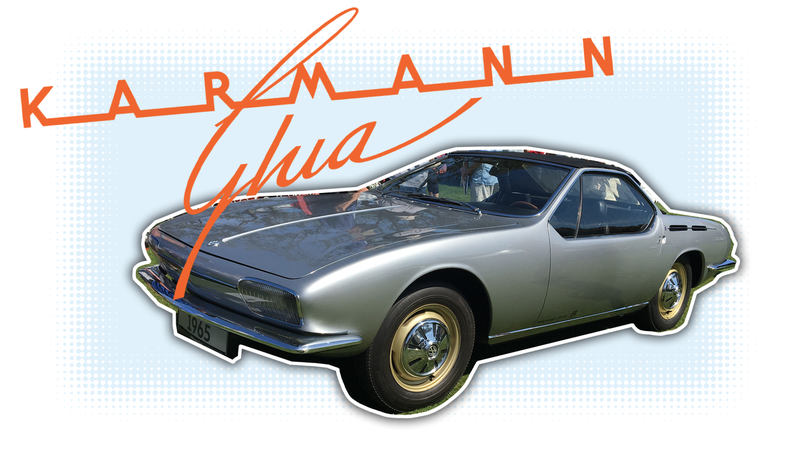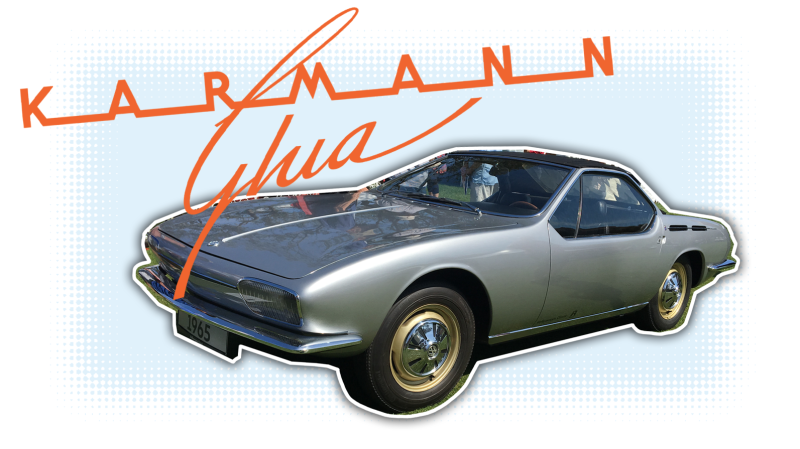
I just got back from the very fancy Amelia Island Concours, which was crammed full of fancy people and fancy cars. This year, though, there was a decidedly less fancy component: For the first time, a separate class of coachbuilt Volkswagens was featured. While pretty much everything in that class was remarkable (and will be covered soon) there’s one fascinating standout I have to share with you: A 1965 Karman-built design study that could have been a replacement for the Karmann-Ghia, if Volkswagen had been interested.

Volkswagen in its golden age of growth, from the early 1950s to the 1970s, was a surprisingly conservative company when it came to major changes. Sure, they were radically different than almost everyone else when it came the technical aspects of how they built cars, but they kept to their basic rear-mounted boxer air-cooled engine and torsion bar suspension formula pretty unceasingly for decades.

That often meant they were, at the very least, highly reluctant to make styling changes just for their own sake. The Karmann Ghia is a great example of this. It was a beautiful (if, maybe just a little bit stolen) design, but very much a design of its era, the 1950s.
Advertisement
Karmann, who built the Karmann-Ghia for Volkswagen, often would design updated versions of the Ghia in hopes Volkswagen would sign off, which they never did.

Karmann did get VW to agree to a higher-end, more modern Ghia in 1961, the Type 3-based Type 34 Ghia, that was an additional model, and the original Ghia kept on as before.
Advertisement
But Karmann never stopped trying to get Volkswagen excited about something new, which is why this particular car exists. So let’s take a look at this amazing car, a 1965 Karmann Ghia design study, built on a normal Type I chassis (the slightly wider version used on the normal Karman Ghia), a car that has never been to America before until this past week.

The car is incredibly modern and striking-looking, I think, especially for 1965. It’s lean and sleek and clean; it has a certain precision of form that would later become more popular in the 1980s.
Advertisement

This thing just feels way ahead of its time. It’s also a pretty dramatic departure from the look and feel of not just the original Karmann Ghia, but pretty much everything else that Volkswagen was building at the time.
Gone are the multiple curves and bulbous shapes, replaced by smooth planes with undercuts and angled cutaways that give the car a lithe and hungry look.
Advertisement
I’m especially fond of the door window cutouts that dip below the beltline of the car. The angled shape of those windows is further defined by the side frames of the body (not actually the door frames, which are frameless), which remain in place even when the soft top is folded down.
This study is also a very interesting demonstration about how flexible VW’s standard platform chassis was for carrying radically different body designs. In our unibody-dominated modern world, this sort of thing is much harder to pull off, but back in the day, VW was basically building a skateboard onto which you could bolt pretty much any body you wanted.
The packaging is pretty great as well; this is a two-seat sports car, but has extremely generous luggage accommodation for a small sports car. Just look at the size of the trunk in this thing:

Advertisement
That’s pretty huge! That thing in the bag there is a gas tank from a motorcycle, since this design study never included a real tank, but even if you imagine a full-size tank in there, it’s still a pretty good-sized trunk.
There’s also some luggage room behind the seats, just like in a regular Karmann Ghia. Unlike a regular Ghia, though, the interior is a real departure from the usual set of VW parts-bin stuff; it feels like a real, high-end sports car of the era:

Advertisement

I mean, look—it has two dashboard turn signal indicators! As you know, getting VW to provide a lavish, decadent two little green arrows to let you know which way you’re turning was next to impossible for decades.
The standard VW Type I engine is a pretty small package, though it is sort of tall. VW mitigated this for a number of their cars, including the Type 2 buses and the normal Ghia by using an offset air cleaner, which is what we find in the generously-sized engine bay of this one-off.
Advertisement

While this is a real car, on a real chassis, and even drivable, it’s still just a design study, so you find some interesting details, like these engine air intake vents:

Advertisement
Yeah, those are just stickers.
Something else you’ll also only notice on design studies is present here, too: the left and right sides are not the same! In order to evaluate two different design ideas for the door handles and side air cooling vents, we find two very different approaches on the car. Here’s the driver’s side:

Advertisement
That’s pretty elegant and fancy, with some nice brightwork trim, and both a Ghia shield-badge and the KARMANN badge at the rear. The door handle is a minimal button and finger cut-out, very clean and slick.
On the passenger side, we get a totally different approach:

Advertisement
I really like this concept here, especially the way the finger-hole for the door handle mimics the look of the engine cooling air vents. This is a bit bolder and sportier than the other side, and gives the car a sort of shark-like quality that I think works.
Which side do you like better? Since this is the internet, and not some filthy old dead-tree magazine, I can find out, in real time, with this poll:
Advertisement
Now we can finally know what we’ll suggest Karmann should do when we get our various time machines up and running.
Seeing this car in person, a car I’ve only seen very occasionally on the internet and in a few books, was absolutely amazing. Hopefully this will start a tradition for Volkswagen, where they drag out long-forgotten prototypes into the light of day, so we can all see them and longingly wonder about what could have been.















